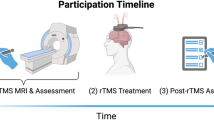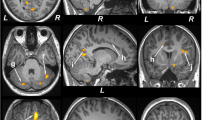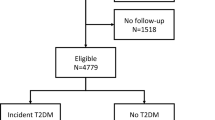Abstract
Type 2 diabetes and major depression are disorders that are mutual risk factors and may share similar pathophysiological mechanisms. To further understand these shared mechanisms, the purpose of our study was to examine the biochemical basis of depression in patients with type 2 diabetes using proton MRS. Patients with type 2 diabetes and major depression (n=20) were scanned along with patients with diabetes alone (n=24) and healthy controls (n=21) on a 1.5 T MRI/MRS scanner. Voxels were placed bilaterally in dorsolateral white matter and the subcortical nuclei region, both areas important in the circuitry of late-life depression. Absolute values of myo-inositol, creatine, N-acetyl aspartate, glutamate, glutamine, and choline corrected for CSF were measured using the LC-Model algorithm. Glutamine and glutamate concentrations in depressed diabetic patients were significantly lower (p<0.001) in the subcortical regions as compared to healthy and diabetic control subjects. Myo-inositol concentrations were significantly increased (p<0.05) in diabetic control subjects and depressed diabetic patients in frontal white matter as compared to healthy controls. These findings have broad implications and suggest that alterations in glutamate and glutamine levels in subcortical regions along with white matter changes in myo-inositol provide important neurobiological substrates of mood disorders.
Similar content being viewed by others
Log in or create a free account to read this content
Gain free access to this article, as well as selected content from this journal and more on nature.com
or
References
Auer DP, Putz B, Kraft E, Lipinski B, Schill J, Holsboer F (2000). Reduced glutamate in the anterior cingulate cortex in depression: an in vivo proton magnetic resonance spectroscopy study. Biol Psychiatry 47: 305–313.
Castillo M, Kwock L, Courvoisie H, Hooper SR (2000). Proton MR spectroscopy in children with bipolar affective disorder: preliminary observations. AJNR Am J Neuroradiol 21: 832–838.
Centers for Disease Control and Prevention (2004). National diabetes fact sheet: general information and national estimates on diabetes in the United States 2003, Rev edn. US Department of Health and Human Services, Centers for Disease Control and Prevention: Atlanta, GA.
Cooper JR, Bloom FE, Roth RH (1996). The Biochemical Basis of Neuropharmacology. Oxford University Press, New York, 7th edn. pp 124–190.
Dager SR, Friedman SD, Parow A, Demopulos C, Stoll AL, Lyoo IK et al (2004). Brain metabolic alterations in medication-free patients with bipolar disorder. Arch Gen Psychiatry 61: 450–458.
D'Agostino RB, Wolf PA, Belanger AJ, Kannel WB (1994). Stroke risk profile: adjustment for antihypertensive medication. The Framingham Study. Stroke 25: 40–43.
de Groot M, Anderson R, Freedland KE, Clouse RE, Lustman PJ (2001). Association of depression and diabetes complications: a meta-analysis. Psychosom Med 63: 619–630.
Eaton WW, Armenian H, Gallo J, Pratt L, Ford DE (1996). Depression and risk for onset of type II diabetes. A prospective population-based study. Diabet Care 19: 1097–1102.
Folstein MF, Folstein SE, McHugh PR (1975). ‘Mini-Mental State’: a practical method for grading the cognitive state of patients for the clinician. J Psychiatr Res 12: 189–198.
Garcia-Espinosa MA, Garcia-Martin ML, Cerdan S (2003). Role of glial metabolism in diabetic encephalopathy as detected by high resolution 13C NMR. NMR Biomed 16: 440–449.
Gavard JA, Lustman PJ, Clouse RE (1993). Prevalence of depression in adults with diabetes. An epidemiological evaluation. Diabet Care 6: 1167–1178.
Geissler A, Frund R, Scholmerich J, Feuerbach S, Zietz B (2003). Alterations of cerebral metabolism in patients with diabetes mellitus studied by proton magnetic resonance spectroscopy. Exp Clin Endocrinol Diabet 111: 421–427.
Goff DC, Coyle JT (2001). The emerging role of glutamate in the pathophysiology and treatment of schizophrenia. Am J Psychiatry 158: 1367–1377.
Hamilton M (1967). Development of a rating scale for primary depressive illness. Br J Soc Clin Psychol 6: 278–296.
Katon WJ, Lin EH, Russo J, Von Korff M, Ciechanowski P, Simon G et al (2004). Cardiac risk factors in patients with diabetes mellitus and major depression. J Gen Intern Med 19: 1192–1199.
Kollokia V (1996). Perfromance analysis of automatic techniques for tissue classification in magnetic resonance images of the human brain (master's thesis, 1996). Department of Computer Science, Concordia University, Montreal.
Kreis R, Ross BD (1992). Cerebral metabolic disturbances in patients with subacute and chronic diabetes mellitus: detection with proton MR spectroscopy. Radiology 184: 123–130.
Kumar A, Cook IA (2002). White matter injury, neural connectivity and the pathophysiology of psychiatric disorders. Dev Neurosci 24: 255–261.
Kumar A, Thomas A, Lavretsky H, Yue K, Huda A, Curran J et al (2002). Frontal white matter biochemical abnormalities in late-life major depression detected with proton magnetic resonance spectroscopy. Am J Psychiatry 159: 630–636.
Linn BS, Linn MW, Gurel L (1968). Cumulative illness rating scale. J Am Geriatr Soc 16: 622–626.
Lipton SA, Rosenberg PA (1994). Excitatory amino acids as a final common pathway for neurologic disorders. N Engl J Med 330: 613–622.
Lustman PJ, Clouse RE (2005). Depression in diabetic patients: the relationship between mood and glycemic control. J Diabet Complicat 19: 113–122.
Lyness JM, Caine ED, Cox C, King DA, Conwell Y, Olivares T (1998). Cerebrovascular risk factors and later-life major depression. Testing a small-vessel brain disease model. Am J Geriatr Psychiatry 6: 5–13.
Makimattila S, Malmberg-Ceder K, Hakkinen AM, Vuori K, Salonen O, Summanen P et al (2004). Brain metabolic alterations in patients with type 1 diabetes-hyperglycemia-induced injury. J Cereb Blood Flow Metab 24: 1393–1399.
Mervaala E, Fohr J, Kononen M, Valkonen-Korhonen M, Vainio P, Partanen K et al (2000). Related Articles, Quantitative MRI of the hippocampus and amygdala in severe depression. Psychol Med 30: 117–125.
Michael N, Erfurth A, Ohrmann P, Arolt V, Heindel W, Pfleiderer B (2003a). Neurotrophic effects of electroconvulsive therapy: a proton magnetic resonance study of the left amygdalar region in patients with treatment-resistant depression. Neuropsychopharmacology 28: 720–725.
Michael N, Erfurth A, Ohrmann P, Arolt V, Heindel W, Pfleiderer B (2003b). Metabolic changes within the left dorsolateral prefrontal cortex occurring with electroconvulsive therapy in patients with treatment resistant unipolar depression. Psychol Med 33: 1277–1284.
Michael N, Erfurth A, Ohrmann P, Gossling M, Arolt V, Heindel W et al (2003c). Acute mania is accompanied by elevated glutamate/glutamine levels within the left dorsolateral prefrontal cortex. Psychopharmacology (Berlin) 168: 344–346.
Murata T, Kimura H, Omori M, Kado H, Kosaka H, Iidaka T et al (2001). MRI white matter hyperintensities, (1)H-MR spectroscopy and cognitive function in geriatric depression: a comparison of early- and late-onset cases. Int J Geriatr Psychiatry 16: 1129–1135.
Palinkas LA, Lee PP, Barrett-Connor E (2004). A prospective study of Type 2 diabetes and depressive symptoms in the elderly: the Rancho Bernardo Study. Diabet Med 21: 1185–1191.
Rosenberg DR, Macmaster FP, Mirza Y, Smith JM, Easter PC, Banerjee SP et al (2005). Reduced anterior cingulate glutamate in pediatric major depression: A Magnetic Resonance Spectroscopy Study. Biol Psychiatry 58: 700–704.
Sanacora G, Gueorguieva R, Epperson CN, Wu YT, Appel M, Rothman DL et al (2004). Subtype-specific alterations of gamma-aminobutyric acid and glutamate in patients with major depression. Arch Gen Psychiatry 61: 705–713.
Sanacora G, Rothman DL, Mason G, Krystal JH (2003). Clinical studies implementing glutamate neurotransmission in mood disorders. Ann NY Acad Sci 1: 292–308.
van der Graaf M, Janssen SW, van Asten JJ, Hermus AR, Sweep CG, Pikkemaat JA et al (2004). Metabolic profile of the hippocampus of Zucker Diabetic Fatty rats assessed by in vivo 1H magnetic resonance spectroscopy. NMR Biomed 17: 405–410.
Vythilingam M, Charles HC, Tupler LA, Blitchington T, Kelly L, Krishnan KR (2003). Focal and lateralized subcortical abnormalities in unipolar major depressive disorder: an automated multivoxel proton magnetic resonance spectroscopy study. Biol Psychiatry 54: 744–750.
Wyckoff N, Kumar A, Gupta RC, Alger J, Hwang S, Thomas MA (2003). Magnetization transfer imaging and magnetic resonance spectroscopy of normal-appearing white matter in late-life major depression. J Magn Reson Imaging 18: 537–543.
Acknowledgements
This research was funded by the National Institute of Health (R01-MH-63674, MH-55115, MH-61567, MH-02043) awarded to Anand Kumar, MD, the General Clinical Research Center (GCRC) and the UCLA Medical Center.
Author information
Authors and Affiliations
Corresponding author
Rights and permissions
About this article
Cite this article
Ajilore, O., Haroon, E., Kumaran, S. et al. Measurement of Brain Metabolites in Patients with type 2 Diabetes and Major Depression Using Proton Magnetic Resonance Spectroscopy. Neuropsychopharmacol 32, 1224–1231 (2007). https://doi.org/10.1038/sj.npp.1301248
Received:
Revised:
Accepted:
Published:
Issue date:
DOI: https://doi.org/10.1038/sj.npp.1301248
Keywords
This article is cited by
-
Alterations of the glutamatergic system in diabetes mellitus
Metabolic Brain Disease (2023)
-
Repeat length variations in polyglutamine disease-associated genes affect body mass index
International Journal of Obesity (2019)
-
RETRACTED ARTICLE: Involvement of the glutamate/glutamine cycle and glutamate transporter GLT-1 in antidepressant-like effects of Xiao Yao san on chronically stressed mice
BMC Complementary Medicine and Therapies (2017)
-
Conceptual convergence: increased inflammation is associated with increased basal ganglia glutamate in patients with major depression
Molecular Psychiatry (2016)
-
Do Anxiety Disorders Play a Role in Adolescent Obesity?
Annals of Behavioral Medicine (2016)



